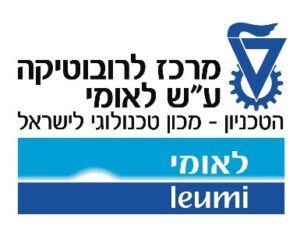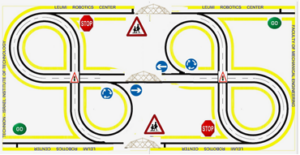
Competition Challenge
The main challenge is to build an autonomous robotic car that can move according to the traffic rules e.g. traffic lights, signs signals and keep safe distance.
The major goals of this competition are:
- Familiarize the students with the traffic laws
- Understand the limitations of the car and driver
- Develop sensors and systems by students that in the long run, will be implemented in real systems in order to reduce the number of car accidents
- Educate the students in the high tech multi-disciplinary area of robots and sensors
- Develop team-working environment.
Participants
1-8 High-School Students per team.
Competition Categories
- Careful Driving
- Extended Careful Driving
- Racing
- Traffic safety initiatives
- Special traffic regulations and rules test
- Advanced Careful Driving
- 3D CAD category.
- Special automatic control basics test.
Competition Method, Rules and Scoring
A. Careful Driving
A playground assigned by the committee is used for two robots line tracing according to the traffic lights and signs signals. Only two representatives from each team should be on the playground. Performance of the robots is judged by its tracing ability without infringements of traffic regulations and accidents for 2 minutes. When the 2 minutes round is completed without infringements and accidents, every team gets 0 penalty points. Each team has 2 attempts. The team with minimum penalty points in one of two attempts is winning. START: when the traffic light turns green, the car starts moving.
The team gets penalty points for the following infringements of traffic regulations:
- No stopping before the stop line at a red light or road sign – 4 points
- Blocking junction – 4 points
- Leaving the route with 4 wheels or stopping – 1 point
- Clash with another car – 5 points
- No stopping at crosswalk – 5 points
- Starting a new game, not by traffic lights – 1 point.
In the case of an equal number of points wins the car with the higher number of cycles. One cycle is a “figure eight”, as well as a part of the cycle.
IMPORTANT!
RIGHT TO OR LEFT sign. First time turn right with the RIGHT TO OR LEFT sign. Second time, when you repeat this sign – go straight. Therefore, we continue in turn – right, straight, right, straight…If not, then 3 penalty points.
Traffic light and Signs codes for programming: Red – 0; Red with Yellow – 1; Green – 2; Green flashing – 3; Yellow – 4; Sign- pedestrian transition – 5; Sign- stop- 6; Sign – right or left – 7.
Careful driving arena (ready for printing).
B. Extended Careful Driving
In addition to Careful Driving category (A), teams should add to car 9 LEDs. Three (3) LEDs (in front of the car) indicate and repeat the traffic light’s signals (simultaneously). Two (2) LEDs in the car front and two (2) LEDs in the back are for indicating of turns. Two (2) LEDs in the car back are for the stop indication. Requirements 2023.
The team gets penalty points for the following infringements of traffic regulations:
- Two red LEDs on the back of the car aren’t activated when the cars stops – 2 points
- The turn signals (blinkers) in the front and rear of the car not activated with the GO RIGHT OR LEFT sign – 2 Points
- When approaching the PEDESTRIAN sign, upper yellow LED does not blink – 2 points
- When approaching the STOP sign, upper red LED does not blink – 2 points
- The car does not turn right with the GO RIGHT or LEFT signs for the first time, or the car does not go straight for even once – 3 points
- The car’s upper LEDs don’t match the traffic light – 1 point
C. Racing
One robot-car must move quickly from start to finish according to the traffic signs signals. Each team has 2 attempts. Racing starts after green light of the traffic light.
START: when the traffic light turns green, the car starts moving.
The fastest car is the winner.
Racing arena (ready for printing).
D. Traffic safety initiatives
This competition includes 7 minutes PowerPoint Oral Presentation.
The team that expresses good knowledge and suggests best new idea to improve real and autonomous cars safety is the winner.
Judging will be according to the following criteria:
- The idea is the most original
- The idea is the most applicable
- The software algorithm is the most effective
- The presentation is the most convincing.
E. Special traffic regulations and rules test
20 questions must be answered with no mistake.
F. Advanced Careful Driving
The requirements for this category will be presented on the Robotraffic site half a year before the competition. Requirements 2023.
G. 3D CAD category
This competition designed to learn a car construction. The team that expresses good knowledge and presents the high-quality 3D CAD file for a given assignment is the winner. Judging will be according to the following criteria:
- a) 3D CAD file quality and complexity.
- b) Oral explanations convincing.
2024 Assignment: draw a double clutch transmission and explain how it works and for what purpose the double clutch transmission is used.
H. Special automatic control basics test
20 questions must be answered with no mistake.
The main subjects: microcontroller programming; proportional-integral-derivative (PID) controller; pulse width modulation (PWM), and H-bridge electronic circuit.
Playground and robotic car dimensions
The playground represents a realistic highway model with intersections. It equipped with traffic lights, road signs, barriers and bridges. The overall dimensions of a possible arena are 900 x 450 cm. The black line width is 50 mm. Car lengths: no more than 425mm. Car width: no more than 210mm.

Leumi Robotics Center, Faculty of Mechanical Engineering, Technion City, IL-3200 Haifa
evgenyk@technion.ac.il Phone: 972-4-829-5490
